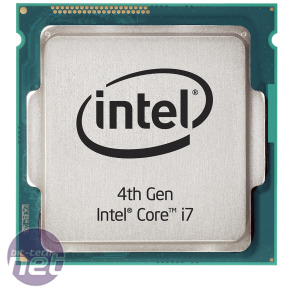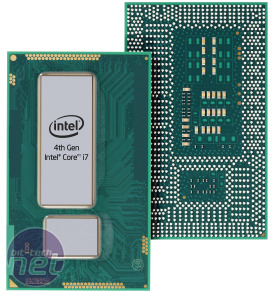Intel Core i7-4770K Review
Manufacturer: IntelUK price (as reviewed): £269 (inc VAT)
US price (as reviewed): $350 (ex tax)
It’s just over 13 months since we last saw a major CPU upgrade from Intel and over two years since anyone wanting to run the latest hardware from the Santa Clara giant had to replace their motherboard. Today, both are happening again. Yes, sadly, it’s time to say farewell to LGA1155, which has served us well - apart from the odd chipset bug and thermal paste rather than solder issue, and hello to Haswell and its new LGA1150 socket.
As many of you may know, Intel tends to operate on a roughly annual tick-tock cycle in terms of product launches. The tick refers to those occasions where the chip design largely stays the same but the manufacturing process takes a step forward, moving from 65nm to 55nm or 32nm to 28nm for instance. This was essentially what we saw with last years Ivy Bridge range, when it upgraded to 22nm from the 32nm of Sandy Bridge.
Sandy Bridge, in turn, was a ‘tock’ launch, where the architecture saw a major overhaul but the manufacturing process stayed the same. It's during these tock cycles that we tend to see socket changes, such as the move from LGA1156 to LGA1155 for Sandy Bridge, and so it is again today - we're still at 22nm but we've a whole new architecture to dissect, which we'll come to shortly. The ‘tocks’ tend to be more exciting as a new architecture can offer significant performance boosts, as we saw from moving from Westmere to Sandy Bridge.
As-per-usual the price of LGA1155 gear is likely to fall as its upgrade path ends so there may be some bargains to be had if you choose wisely, though frankly we'd imagine you have to be pretty lucky to find a bargain that really makes it worth buying new Ivy Bridge kit. Thankfully, for those that are upgrading, we’re not looking at a RAM upgrade as well - it'll just be the motherboard and CPU that need swapping out.
| Intel Core i5-4670T | Intel Core i5-4670S | Intel Core i5-4670K | Intel Core i5-4670 | |
| Multiplier | Locked | Locked | Unlocked | Locked |
| TDP | 45W | 65W | 84W | 84W |
| Nominal Frequency | 2.3 | 3.1 | 3.4 | 3.4 |
| Max Turbo Boost Frequency | 3.3 | 3.8 | 3.8 | 3.8 |
| Hyperthreading | N | N | N | N |
| Physical Cores | 4 | 4 | 4 | 4 |
| Level 3 Cache | 6MB | 6MB | 6MB | 6MB |
| Graphics | Intel HD 4600 | Intel HD 4600 | Intel HD 4600 | Intel HD 4600 |
| GPU Frequency | 1,200MHz | 1,200MHz | 1,200MHz | 1,200MHz |
| Intel Core i7-4770T | Intel Core i7-4770S | Intel Core i7-4770 | Intel Core i7-4770K | Intel Core i7-4770R | Intel Core i7-4765T | |
| Multiplier | Locked | Locked | Locked | Unlocked | Locked | Locked |
| TDP | 45W | 65W | 84W | 84W | 65W | 35W |
| Nominal Frequency | 2.5 | 3.1 | 3.4 | 3.5 | 3.2 | 2 |
| Max Turbo Boost Frequency | 3.7 | 3.9 | 3.9 | 3.9 | 3.9 | 3 |
| Hyperthreading | Y | Y | Y | Y | Y | Y |
| Physical Cores | 4 | 4 | 4 | 4 | 4 | 4 |
| Level 3 Cache | 8MB | 8MB | 8MB | 8MB | 6MB | 8MB |
| Graphics | Intel HD 4600 | Intel HD 4600 | Intel HD 4600 | Intel HD 4600 | Intel Iris 5200 | Intel HD 4600 |
| GPU Frequency | 1200MHz | 1200MHz | 1200MHz | 1250MHz | 1300MHz | 1200MHz |
What’s new with Haswell?
From the top, not a lot has changed as far as naming schemes and frequencies go. The CPU we’re looking at today, the Core i7-4770K, is as you’ve probably guessed, the successor to the Core i7-3770K, which offers four physical cores and four virtual ones thanks to hyper-threading. K-series CPUs still sport unlocked multipliers, which makes the other CPU that has been officially unveiled today - the Core i5-4670K - the potentially more interesting one for the masses who don't need hyper-threading. We'll have to wait for a review sample to see just how interesting, though. Why the move from ‘570K’ to ‘670K’ we have no idea, but it takes the place of the venerable Core i5-3570K.
Both CPUs have TDPs of 84W, which is actually 7W higher than their Ivy Bridge counterparts and roughly half way between those and unlocked Sandy Bridge CPUs, while the transistor count remains relatively static at 1.4billion. The base and Turbo Boost frequencies of the Core i7-4770K are the same as the Core i7-3770K too, at 3.5GHz and 3.9GHz respectively, and there’s been no change on the Level 3 cache amount, which remains at 8MB. The same is true for the Core i5-4670K, which has identical clock speeds and cache amounts to its Ivy Bridge predecessor.
Some of the most interesting aspects of Haswell then are a much-needed boost to its on-board graphics, better power saving and greater efficiency. The Haswell Architecture scales quite dramatically when it comes to power consumption, with today’s CPU range starting at just 15W for the Core i7-4650U all the way up to 84W for the Core i7-4770K, with higher TDP CPUs in the pipeline too.
On the graphics side of things, Intel has introduced on-chip memory in the form of an eDRAM cache. Until now, APUs such as AMD’s A10-5800K have mostly tapped into system RAM for the integrated graphics processor, with the result being that if you use faster RAM in your system, you’ll see better performance in games if you’re not using a discrete graphics card.
However, this isn’t as good as having on-package RAM and that’s exactly what Intel is introducing here, albeit only with a select few desktop CPUs sporting Intel Iris graphics, which have the ‘R’ designation such as the Intel Core i7-4770R. The eDRAM sits on a separate die to the Haswell core, in addition to new on-die voltage regulation circuitry – another first - but we still expect these CPUs especially to show a significant boost in IGP performance over Ivy Bridge CPUs. The GPU supports DirectX 11.1 and DisplayPort 1.2, with it possible to daisy-chain up to three displays (one screen at 4096x2304 and 24Hz with the others at 3840x2160@60Hz).

MSI MPG Velox 100R Chassis Review
October 14 2021 | 15:04











Want to comment? Please log in.